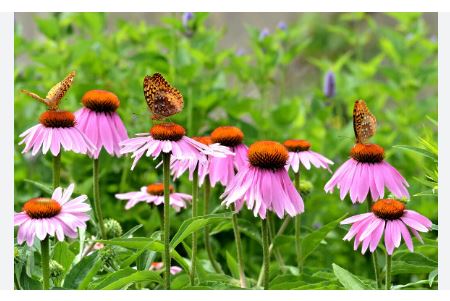
Echinacea purpurea, commonly known as Purple Coneflower, is part of the Echinacea genus within the Asteraceae family, which is also known as the daisy or sunflower family. This species is characterized by its large, daisy-like flowers with prominent, cone-shaped, spiny central disks surrounded by drooping, purple to pink petals. The name “Echinacea” comes from the Greek word “echinos,” meaning hedgehog or sea urchin, referring to the spiny central cone.
Purple Coneflower is native to the eastern and central regions of North America. Its natural range includes areas from Pennsylvania in the Northeast, south to Georgia, and west to Oklahoma and Louisiana. It grows in various habitats, including open woods, prairies, and along roadsides, where it prefers well-drained soils in full sun or partial shade.
Historically, Echinacea purpurea has been significant among Native American tribes, particularly the Plains tribes like the Lakota and Cheyenne, who used it for medicinal purposes. They utilized the plant to treat a wide array of ailments, from wounds and snakebites to infections and toothaches. Its immune-boosting properties have made it one of the most widely used herbal remedies in modern times, particularly in the form of Echinacea supplements aimed at fighting colds and boosting the immune system. In the 19th century, it was adopted by European settlers and later became popular in horticulture for its ornamental value, leading to the development of numerous cultivars with different flower colors and forms. The Purple Coneflower has also become an emblematic species in native plant gardening for its ecological benefits, attracting pollinators and supporting biodiversity.
Purple Coneflower is well-adapted to USDA Hardiness Zones 3 through 9. This broad range reflects its resilience to diverse climates, from the cold winters of northern zones to the hot, humid summers of the South. It thrives in conditions that mimic its native environment, requiring good sunlight for optimal flowering but also showing tolerance for some shade. Its adaptability to various soil types, though preferring well-drained soils, makes it a versatile choice for both formal gardens and naturalistic landscapes. Its hardiness, combined with its medicinal and ecological value, has cemented its place in both gardens and health practices.
Purple Coneflower (Echinacea purpurea): Characteristics
- Flower Appearance: Features large, daisy-like flowers with a raised, spiny, dark central cone surrounded by drooping petals. The petals are typically purple to pink, though there are cultivars in various colors.
- Bloom Time: Blooms from early to mid-summer, often continuing into fall, providing a long season of interest. Deadheading can extend the blooming period.
- Growth Habit: Grows as a clump-forming perennial, reaching heights of 2 to 4 feet with a spread of 1 to 2 feet, creating a bushy, upright habit.
- Leaves: Leaves are coarse, lance-shaped, and have a rough texture, with a dark green color. They are arranged alternately on sturdy stems, with basal leaves forming a rosette.
- Root System: Has a fibrous root system, which not only anchors the plant well but also allows for easy division for propagation. The root is thick and can be used for medicinal purposes.
- Adaptability: Highly adaptable to various soil types, preferring well-drained, loamy soils but tolerating both dry and somewhat moist conditions. Thrives in full sun but can handle partial shade, especially in hotter climates.
- Pollinator Attraction: A significant draw for bees, butterflies, and other pollinators, including hummingbirds. The central cone also provides seeds for birds in late fall and winter.
- Drought Tolerance: Once established, it’s moderately drought-tolerant, making it suitable for xeriscaping or gardens where water conservation is a priority.
- Medicinal Properties: Widely known for its immune-boosting properties, with the roots, leaves, and flowers used in herbal medicine for centuries. Echinacea supplements are popular for their potential to reduce cold symptoms.
- Ecological Role: Supports biodiversity by providing habitat and food for pollinators during its bloom and for seed-eaters afterward. It’s also considered a good companion plant in vegetable gardens for its pest-repellent qualities.
Purple Coneflower (Echinacea purpurea): Cultivation
- Site Selection: Opt for a location with full sun exposure for best flowering, though it can manage with some afternoon shade in very hot climates. Six hours of direct sunlight daily is recommended.
- Soil Preparation: Prefers well-drained, loamy soil but is adaptable to various soil types. Enhance heavy clay soils with organic matter or sand to improve drainage. It thrives even in relatively poor soil.
- Planting: Plant in spring after the last frost or in fall. Space plants 1 to 2 feet apart to allow for air circulation and growth. Sow seeds directly in fall for natural stratification or start indoors 6-8 weeks before last frost for transplants.
- Watering: Water deeply after planting to help roots establish. Once established, it’s moderately drought-tolerant but will benefit from watering during extended dry periods, particularly in the first year.
- Mulching: Use a light mulch layer to retain soil moisture, suppress weeds, and protect against temperature fluctuations. Keep mulch away from the crown to prevent rot.
- Fertilization: Fertilize sparingly; too much can lead to lush foliage at the expense of blooms. A light application of a balanced, slow-release fertilizer in early spring might be beneficial if soil is very poor.
- Pruning and Maintenance: Deadhead spent flowers to encourage more blooming and to control self-seeding. Cutting back by about one-third after the first bloom can sometimes stimulate a second flowering. Leave some seed heads for wildlife in winter.
- Pest and Disease Management: Generally pest-resistant, but watch for aphids or fungal diseases like powdery mildew, especially in wet conditions. Good spacing and air circulation can prevent most issues.
- Propagation: Propagate by seeds, which benefit from cold stratification, or by division in spring or fall. Division every few years can rejuvenate older plants, promoting vigor and bloom.
- Winter Care: In colder zones, apply a light mulch around the base for root protection. Echinacea is hardy but mulching can help in extreme conditions. In warmer zones, it may act as a short-lived perennial or self-seed.